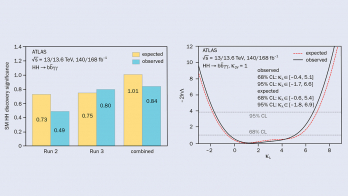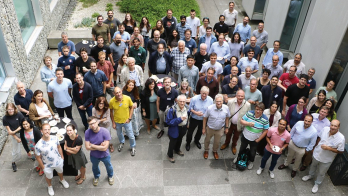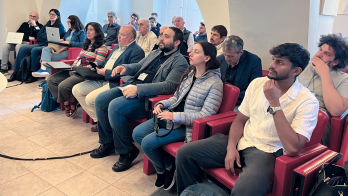Working at the forefront of calculations of the Higgs boson’s properties, Sally Dawson explains how the codependence of theory and experiment is driving a deeper understanding of the new particle.

What impact did the discovery of the Higgs boson have on your work?
It was huge because before then it was possible that maybe there was no Higgs. You could have some kind of dynamical symmetry breaking, or maybe a heavy Higgs, at 400 GeV say, which would be extremely interesting but completely different. So once you knew that the Higgs was at the same mass scale as the W and the Z, our thinking changed because that comes out of only a certain kind of model. And of course once you had it, everyone, including myself, was motivated to calculate everything we could.
I am working on how you tease out new physics from the Higgs boson. It’s the idea that even if we don’t see new particles at the LHC, precision measurements of the Higgs couplings are going to tell us something about what is happening at very high energy scales. I’m using what’s called an effective field theory approach, which is the standard these days for trying to find out what we can learn from combining Higgs measurements with other types of measurements, such as gauge-boson pair production and top-quark physics.
Aside from the early formal work, what was the role of Standard Model calculations in the discovery of the Higgs boson?
You had to know what you were looking for, because there’s so many events at the LHC. Otherwise, it would be like looking for a needle in a haystack. The Higgs was discovered, for example, by its decay to two photons and there are millions of two-photon events at the LHC that have nothing to do with the Higgs. Theory told you how to look for this particle, and I think it was really important that a trail was set out to follow. This involves calculating how often you make a Higgs boson and what the background might look like. It wasn’t until the late 1980s that people began taking this seriously. It was really the Superconducting Super Collider that started us thinking about how to observe a Higgs at a hadron collider. And then there were the LEP and Tevatron programmes that actively searched for the Higgs boson.
To what order in perturbation theory were those initial calculations performed?
For the initial searches you didn’t need the complicated calculations because you weren’t looking for precision measurements such as those required at the Z-pole, for example. You really just needed the basic rate and background information. We weren’t inspired to do higher order calculations until later in the game. When I was a postdoc at Berkeley in 1986, that’s when I really started to calculate things about the Higgs. But there was a long gap between the time when the Brout–Englert–Higgs mechanism was proposed and when people really started doing some hard calculations. There’s the famous paper in 1976 by Ellis, Gaillard and Dimopoulos that calculated how the Higgs might be observed, but in essence it said: why bother looking for this thing, we don’t know where it is! So people were thinking we could see the Higgs in kaon decays, if it was very light, and in other ways, and were looking at the problem in a global kind of way.
Was this what drove your involvement with The Higgs Hunter’s Guide in 1990?
We were further along in terms of calculating things precisely by then, and I suppose there was a bit of a generation gap. It was a wonderful collaboration to produce the guide. We still went through the idea of how you would find the Higgs at different energy scales because we still had no idea where it was. The calculations went into high gear around that time, which was well before the Higgs was discovered. Partly it was the motivation that we were pretty sure we would see it at the LHC. But partly it was developments in theory which meant we could calculate things that we never would have imagined was possible 30 years earlier. The capability of theorists to calculate has grown exponentially.
What have these improvements been?
It’s what they call the next-to-next-to-leading order (NNLO) revolution – a new frontier in perturbative QCD where diagrams with two extra emissions of real or extra loops of virtual partons are accounted for. These were new mathematical techniques for evaluating the integrals that come into the quantum field theory, so not just turning the crank computationally but really an intellectual advance in understanding the structure of these calculations. It started with Bern, Dixon and Kosower, who understood the needed amplitudes in a formal way. This enabled all sorts of calculations, and now we have N3LO calculations for certain Higgs-boson production modes.
What is driving greater precision on Higgs calculations today?
Actually it’s really exciting because at the high-luminosity LHC (HL-LHC), experimentalists will be limited in their understanding of the Higgs boson by theory – the theory and experimental uncertainties will be roughly the same. This is truly impressive. You might think that these higher order corrections, which have quite small errors, are enough but they need to be even smaller to match the expected experimental precision. As theorists we have to keep going and do even better, which from my point of view is wonderful. It’s the synergy between experiment and theory that is the real story. We’re co-dependent. Even now, theory is not so different from ATLAS and CMS in terms of precision. Theory errors are hard things to pin down because you never really know what they are. Unlike an absolute statistical uncertainty, they’re always an estimate.
How do the calculations look for measurements beyond the LHC?
It’s a very different situation at e+e– colliders compared to hadron colliders. The LHC runs with protons containing gluons, so that’s why you need the higher order corrections. At a future e+e+ collider, you need higher-order corrections but they are much more straightforward because you don’t have parton distribution functions to worry about. We know how to do the calculations needed for an e+e– Future Circular Collider, for example, but there is not a huge community of people working on them. That’s because they are really hard: you can’t just sit down and do them as a hobby, they really need a lot of skills.
You are currently leading the Higgs properties working group of the current Snowmass planning exercise. What has been the gist of discussions?
This is really exciting because our job has essentially been to put together the pieces of the puzzle after the European strategy update in 2020. That process did a very careful job of looking at the future Higgs programme, but there have been developments in our understanding since then. For example, the muon collider might be able to measure the Higgs couplings to muons very precisely, and there has been some good work on how to measure the couplings to strange quarks, which is very hard to do.

I would like to see an e+e– collider built somewhere, anywhere. In point of fact, when you look at the proposals they’re roughly the same in terms of Higgs physics. This was clear from the European strategy report and will be clear from the upcoming Snowmass report. Personally, I don’t much care whether there is a precision of 1% or 1.5% on some coupling. I care that you can get down to that order of magnitude, and that e+e– machines will significantly improve on the precision of HL-LHC measurements. The electroweak programme of large circular e+e– colliders is extremely interesting. At the Z-pole you get some very precise measurements of Standard Model quantities that feed into the whole theory because everything is connected. And at the WW threshold you get very precise measurements in the effective field theory of things that connect the Higgs and WW pairs. As a theorist, it doesn’t make sense to think of the Higgs in a vacuum. The Higgs is part of this whole electroweak programme.
What are the prospects for finding new physics via the Higgs?
The fact that we haven’t seen anything unexpected yet is probably because we haven’t probed enough. I’m absolutely convinced we are going to see something, I just don’t know what (or where) it is. So I can’t believe in the alternative “nightmare” scenario of a Standard-Model Higgs and nothing else because there are just so many things we don’t know. You can make pretty strong arguments that we haven’t yet reached the precision where we would expect to see something new in precision measurements. It’s a case of hard work.
What’s next in the meantime?
The next big thing is measuring two Higgs bosons at a time. That’s what theorists are super excited about because we haven’t yet seen the production of two Higgses and that’s a fundamental prediction of our theory. If we don’t see it, and it’s extremely difficult to do so experimentally, it tells us something about the underlying model. It’s a matter of getting the statistics. If we actually saw it, then we would do more calculations. For the trilinear Higgs coupling we now have a complete calculation at next-to-leading order, which is a real tour de force. The calculations are sufficient for a discovery, and because it’s so rare it’s unlikely we will be doing precision measurements, so it is probably okay for the foreseeable future. For the quartic coupling there are some studies that suggest you might see it at a 100 TeV hadron collider.
With all the Standard Model particles in the bag, does theory take more of a back seat from here?
The hope is that we will see something that doesn’t fit our theory, which is of course what we’re really looking for. We are not making these measurements at ever higher precisions for the sake of it. We care about measuring something we don’t expect, as an indicator of new physics. The Higgs is the only tool we have at the moment. It’s the only way we know how to go.








